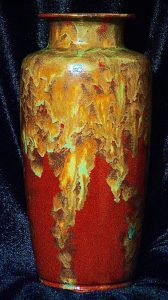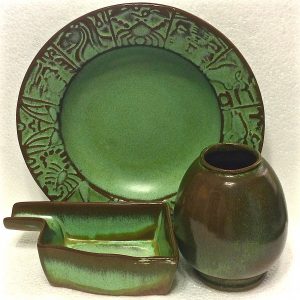John N. Frank:
“A Philosophy of Modern Ceramics”
An academic paper presented at the meeting of the
American Ceramic Society,
Southwest Section,
circa 1958
Although Ceramic Art of all things is not a new subject, we might say that Modern Ceramics is a development of the last fifty years. Like all new things, fads, or fashions, all who are interested get into the swim and try their hand at expression. It is natural that some good and a lot of bad come from this free for all. With the turn of the century there has been a grand scale exploitation of clays and everything that clay will make.
This is a very fine thing for nothing progresses without that trial and error stage. We have attempted everything from pins to bath tubs, and have found some sharp pins and interesting bath tubs. We have been able to build the finest tunnels in the world because we lined them with ceramic tile, and the most beautiful permanent skyscrapers because we have built them of glazed terra cotta.
This is not an attempt to promote a new idea of art or destroy any convictions you may have about art or ceramics, or attempt to convert any one over to a new philosophy. Nor is this an attempt to discredit our so-called “Modern Art” or elevate that of any period. Rather this is to try and analyze the qualities that are required of ceramic art in order to stand the test of time as a work of art, and to evaluate it in the light of modern living. I hope this will add to your enjoyment in creating and possessing truly fine ceramic art.
Shakespeare said that, “The evil that men do live after them, but the good is oft interred in their bones.” This is conversely so with art. Fortunately, the good art that is produced in each age and country lives on, and most of the bad is soon lost in the shuffle and forgotten. Our museums are filled with the fine things of the ages, and the bad that is shown is kept purely for record sake. Of the vast multitude of artists working in clay today, those who excel soon find their way out of the crowd and are held up for the masses to enjoy. Art doesn’t just happen. It is very directive and purposeful. Fine ceramics do not just happen, no more than poetry comes out of a typewriter accidentally.
It seems the air is charged with the myriads of wonders of science, and few of us have the least ability to understand them. It seems that we can make anything – anything but clay. The creator alone still holds the secrets of life and the plasticity of clay. This is a significant note for me, for it has been this fascinating mystic thread of interest that has brought pottery making through all ages of man’s existence. It seems that there is a close kinship between man and clay, since man is purported to have come from the earth himself.
Art Is Harmony
Ceramics is the “Art of Arrested Reactions,” the product of all influences coming in contact with it during its formative life, in the same light that our characters are also a product of life’s influences. Thus to create the kind of ceramics that we enjoy living with, the kind of characters that enhance our lives, it is necessary that we understand the philosophy that directs that kind of creative thinking. From our point of view, we are only interested in those ceramics that are designed for beautiful living.
According to Webster, art is the application of skill and taste to the production of beautiful things, those objects possessing such delicacy of outline, exquisite color, or harmony of proportion as arouses pleasurable emotions in the beholder. According to this, we might well dismiss from our consideration those things that to us are hideous, repulsive, or ugly, regardless of what evaluation certain art critics place upon a piece, or who signs it.
Art has two excuses for existence: First to satisfy the artists desire for expression as he sees and fells it, and as he wishes to express it for his own satisfaction. This is a perfectly legitimate motive in spite of the criticism he might get from those who are not prepared to share his views. Second, that by its possession or association, we might be happier, lovelier, richer, finer, more livable.
 Art is harmony. In ceramics it is harmony of line, mass, proportion, color, texture – all of which produce an atmosphere, a unity, or a character, if you please. Clay by its very nature invites ones caresses; it is a personal craft, and lends itself to the art “you love to live with.” Stone and concrete are hard and cold. Pottery is “won from the flames,” it should be warm and affectionate. You carve stone with a hammer and chisel, you hammer metal, or apply colors with a brush, but you guide clay into its infinite details of loveliness by gentle caressing with your fingertips. So closely akin is pottery to the artist creating it that the temperament and even sometimes the nationality of the artist is discernible by even the layman admirer.
Art is harmony. In ceramics it is harmony of line, mass, proportion, color, texture – all of which produce an atmosphere, a unity, or a character, if you please. Clay by its very nature invites ones caresses; it is a personal craft, and lends itself to the art “you love to live with.” Stone and concrete are hard and cold. Pottery is “won from the flames,” it should be warm and affectionate. You carve stone with a hammer and chisel, you hammer metal, or apply colors with a brush, but you guide clay into its infinite details of loveliness by gentle caressing with your fingertips. So closely akin is pottery to the artist creating it that the temperament and even sometimes the nationality of the artist is discernible by even the layman admirer.
Any art, by definition and necessity, embodies an emotional expression of the artist. “Stuff” that is created by slapstick methods and promoted as art is doomed to die when the promotion is over. Art without an emotional, intelligent soul in back of it, is as dead as an abandoned church. We might not understand all that the artist meant to convey, but its valve as a work of art will be determined by its ability to convey the artist’s story in the medium chosen. Sometimes we are so close to the things done that it takes years to realize how well our art has depicted the emotional life of that particular time. Whether we realize it or not, the way we live and think naturally comes out in the art we produce.
So much has been done in recent years to give all who so wish a general education and understanding of art. This has given thousands the inspiration to try their hand at creating, and many have stood out as contributing fine things to the Art World that it never would have had, had art been kept in the “long hair” class as in the past. This has helped many to better evaluate and appreciate fine things, for one can’t fully appreciate any art with which they have no experience. It is not fair for a layman, who has no knowledge of art, to criticize those who have given their lives to creating; he should not be expected to talk a language he doesn’t know.
Sugar Bowls Don’t Need Lids
In pictures and sculpture we have been accustomed to expecting the subject matter to be something we understand, or even an accurate portrayal of it. We don’t seem to mind distorted shadows, or abstract backgrounds, but we want to recognize it in the light of our experiences. To fulfill our traditional requirements does not make a piece good, neither does a departure from our personal thinking make it bad. Modern artists have accentuated the object of his expression at the sacrifice of the subject. He has become more absorbed in his experience than in the surrounding world.
Ceramics has felt that same development. Although the Greeks did worship the human figure and were so figure-conscious that they even made their pottery after it, the resultant works were fine pieces of art, in spite of the inspiration, and not necessarily because of it. Subject matter is only a source of inspiration. It is not fair to expect an artist to match the loveliness of a maiden’s cheek in clay, but he can create colors, forms, textures and atmosphere of his own that do not betray his medium, and that do credit to his earthen materials and his own creative imagination. Art by its very mature is creative, and copies are but a weak admission of the lack of a constructive thought.
 Much of the creations exhibited in the shows across the country are good exercises, and from a purely design standpoint they may stand up to criticism. They may be good line, proportion, color, and texture, and may be derived from intelligible subject matter, but may lack the one thing that it takes to perpetuate a work of art – that abstract quality, Character. As a layman I don’t expect a sculptured figure to come to life and breathe, nor do I expect to find its texture skin-like and warm, but I do respond warmly when the artist has been able to portray these forms honestly, constructively, sympathetically. Much “art” has been produced to be as hideous as possible and still stay within the bounds of the critic’s analysis.
Much of the creations exhibited in the shows across the country are good exercises, and from a purely design standpoint they may stand up to criticism. They may be good line, proportion, color, and texture, and may be derived from intelligible subject matter, but may lack the one thing that it takes to perpetuate a work of art – that abstract quality, Character. As a layman I don’t expect a sculptured figure to come to life and breathe, nor do I expect to find its texture skin-like and warm, but I do respond warmly when the artist has been able to portray these forms honestly, constructively, sympathetically. Much “art” has been produced to be as hideous as possible and still stay within the bounds of the critic’s analysis.
A most important phase of ceramic designing is appropriating the design to the object. The article is a definite part of the design, and cannot be divorced from it. Line, mass, texture, and color are inseparable parts of ceramic design, but the artist should only be limited by these requirements. Sugar bowls don’t need lids. Some pitchers don’t need handles, plates don’t need tea roses to support potatoes and gravy, tea cups may be any good shape. Flower bowls can be formed from any inspiration, conventional or abstract. Function, color, and design are most important.
As the art of all ages was expressive of the times in which it was produced, our art productions today also reflect our times, socially, spiritually, politically and emotionally. As much as we might criticize the so-called “modern art” today, the thread of good that is always prevalent in any age will be perpetuated and known as the “contemporary art.” True artists today are trying to be honest in representing their emotions, and produce more human, more universal, and more understandable things.
Clay Is Full of Adventure
Our ceramic industry is a myriad of every kind of thinking, and every kind of experiment, challenging themselves to present to the layman an honest application of experiences in clay – characters in clay. No medium presents a greater challenge to the artist than clay. It takes form so rapidly at the slightest touch of the finger, as to respond with a willingness to be whatever the master wishes. Clay is so full of adventure that I am sure it is insulted when forced to be a cheap copy of someone else’s dreaming. It longs for honest expression, struggles for freedom of form, and asks to be represented with the fairest integrity.









Speak Your Mind